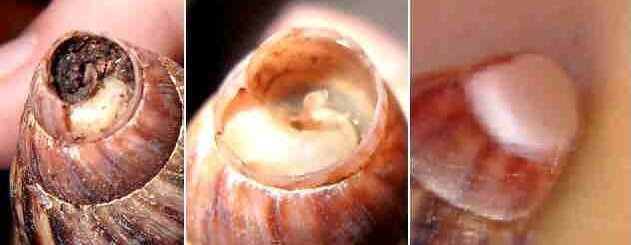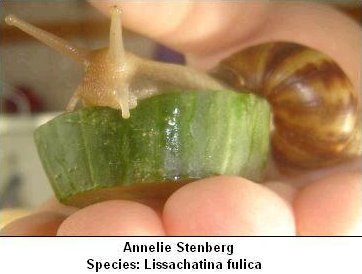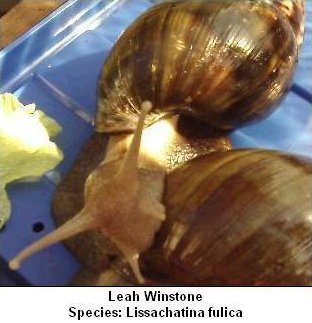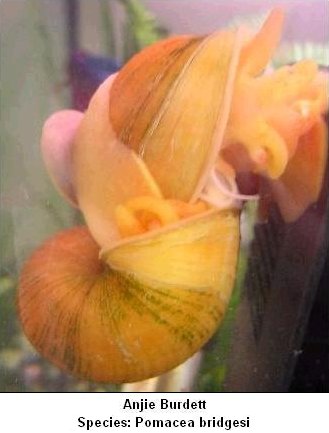
In this issue:
- Foreword
- Society Aims
- Broken Shell Care
- Brixton Snails
- Achatina fulica
- Cornu aspersum
- Fun Page
- Photo Page
Welcome to the first publication of the International Gastropod Society, our very first newsletter!
Information on these animals is quite difficult to obtain and even more difficult to make sense of. In terms of bridging the gap between scientific scholars and those of us who wish to keep them as pets, there hasn't been much achieved and many of the realms of accepted knowledge and practice for other pets simply don't exist for gastropods.
This society of volunteers was formed out of a desire to try and change this situation and to supercharge the hobby of gastropod-keeping generally. We hope to give everyone who is interested in these animals, a voice that will be taken more seriously and hopefully allow us access to many research facilities, that we as individuals would otherwise struggle to exploit or gain access to.
However, this is only half of the story because the scientific community is mainly interested in snails as research material. As a result, any care research undertaken, by their own admission, has always aimed to keep a successful, breeding population of snails, rather than to try and find the perfect conditions for happy and healthy snails. Illness would no doubt be eradicated by means of euthanasia and so research in areas we are particularly interested in is left for us alone to engage in. This has changed a little in recent years with a number of projects to rescue species nearing extinction and so the time for a deeper understanding of their needs has arrived, something we can perhaps be a part of.
A society gives us the profile to attract help and support from all areas, allowing us to bring information together so we can collectively make sense of it. Our society is world-wide and we hope that country-specific contingents will emerge to help coordinate between all the various languages spoken and to hopefully arrange events and lectures. We are non-profit making in the sense that any money earned in any way will be put straight back into the society to pay costs, obtain books, scientific papers etc. or to arrange events.
There are many ways to get involved from helping us find information, sending emails and letters on behalf of the society, visiting museums, getting involved in research projects and many, many more. I have no doubt this will be discussed at length as time progresses and I'd certainly recommend you reading through our aims (included in this newsletter) and the frequent discussion at our on-line forum.
With the Internet at our fingertips we can work together to map out the snail world in terms of information and raise the profile of both gastropods and the hobby of keeping them. We have a website that will be continually developed to allow us to collaborate on-line and stop us duplicating our efforts.
It is to be hoped that the enthusiasm this society has been founded upon can pique and renew interest in gastropods generally, scientifically and conservationally. We can inform these communities of our existence and offer our help wherever possible to help them conduct research. It seems that the age of amateur research has waned a little and perhaps we can reinvigorate it.
Besides this thirst for information, we are also particularly interested in the welfare of gastropods and it is hoped we can open a dialogue with pet shops and traders who are not keeping their snails to a reasonable standard of care, something which unfortunately we often hear about. This aim will no doubt require some imaginative thought and a vast network of eyes and ears of people who care, so we are perfectly suited to the task.
In fact, we are interested in all aspects of gastropods because our members are, so naturally groups of interest will form within the society to drive particular areas.
Perhaps one of the most important functions of this society is to bring us all together as a world-wide community of people who adore or are fascinated by gastropods, and to collaborate harmoniously so we can achieve in years, what one of us alone would take many lifetimes to approach.
Paul King
- To compile a comprehensive encyclopedia of snail knowledge, both scientific and from a pet point of view.
- To compile a comprehensive collection of snail pictures.
- To attempt to solve, document, revise and construct reliable identification methods and information, both written, photographic and computer-aided.
- To be a comprehensive directory of websites, breeders and shops.
- To actively increase awareness about snails and their care and to encourage responsible ownership.
- To open a dialogue with traders and sellers to protect the welfare of gastropods.
- To facilitate a minding service for people in similar locations.
- To research and to encourage research from others.
- To combine all our efforts towards a common goal.
- To find ways to involve people from all over the world.
- To educate and to inform.
- To be an umbrella to various snail sites/organisations that wish to participate.
- To be a hub of communication for snail-lovers with a whole host of facilities at their disposal.
- To eventually support malacology and conchology organisations regarding Achatinidae in particular.
- To give us influence and the ability to do that which one person alone could not do, such as getting trade accounts and access to certain information and/or facilities.
- To share our information with everyone and anyone.
by Natalie Vincent
Please note this is just a guide and my experience. All shell repairs must be undertaken at your own risk. Quite often a snail suffers a break to its shell. Be it from falling from the tank lid, during transit to you, or from ill treatment before you owned it. A lot of these breaks, especially those at the edge of the shell, will heal themselves with plenty of cuttlefish. But some further down the shell, or when the tip gets broken off may need repairing. I advise you only do this if you can see into the shell and you think the snail is at risk of infection.
Here is the way I have repaired breaks my snails have suffered. Equipment you will need:
- Clean soft baby's toothbrush
- Cooled boiled water
- Plaster of Paris
- Cotton buds
- Gauze
- Clean tissue/wipes
- Clear quick dry nail varnish
| 1. |
Choose a time when your snail is very sleepy, have everything you need in front of you and get your snail out of his tank. First you need to clean all around the area of the break and inside the hole gently with the toothbrush, without poking into it. Keep rinsing with the cooled boiled water.
|
||||||||||
| 2. |
Once you are satisfied with it being clean enough you can get ready to fill it. The plaster of paris needs to be made with cooled boiled water and mixed extremely thickly. So its almost a dough but not powdery. This is so that it doesn't run inside the shell to the snails organs.
|
||||||||||
|
|||||||||||
| 3. |
Now you have to wait for the plaster to dry, if you made it right it shouldn't run at all. If snail is awake now it might be an idea to give them a rest and a snack, away from other snails that might get at the plaster of paris.
|
||||||||||
| 4. |
Once dry (approximately 1 hour) you can begin applying nail varnish over the plaster of paris. This protects the plaster of paris for being chipped or rasped away. Quick dry nail varnish makes this job far easier as you will need to do a few coats. I did 6 with each of mine and that's still untouched.
|
||||||||||
| 5. |
Make extra sure the nail varnish is dry before putting your snail down, and back with others. Apart from checking the nail varnish every so often in case its wearing away your snail should now be 'as good as new'.
|
||||||||||

by Anjie Burdett
I had heard talk of the African food market at Brixton and the snails that were sold there as a food item, I was told they were piled high in baskets....all stacked on top of each other, deprived of food and water until they were sold and taken home by someone who was going to cook them!
That's when I decided to go myself, Arno Brosi came over from Holland so we could go together and SHOCK....HORROR.....we were told they wouldn't have any snails until the week after. How disappointing that was I can't put into words but I didn't give up, I went back again a week or so later and eventually found the shop that had said they would have some. I couldn't believe my eyes, a huge Margie slithering across the pavement! It was unreal, never forget it. Here I was in a market in South London and here was the biggest snail I had ever seen in my life wandering around on the pavement!
The snails were indeed in baskets, except the ones that were strong enough to escape onto the pavement - those were the ones I bought first. I bought as many as I could afford and they were all thrown into plastic carrier bags, I think I bought 30(ish) on my first visit. It's not nice having to wade through dead and stinking snails to find the ones that are even half alive, but its so worth it when you get home and gently scrub the shells clean to reveal beautiful stripes. The majority of the snails I have bought from Brixton have been Margies but I was fortunate enough on 2 visits to find Tiger snails too.
Brixton snails have been badly treated, starved, dehydrated and thrown around like rubbish - they need more care than your average captive-bred Margie or Tiger. After cleaning I put them in bare tanks with no substrate, a dish of water and some fairly bland food - lettuce or cucumber. They don't usually eat for the first day or so but one thing they always do is drink. I leave them alone as much as possible the first night, they are still extremely shy and I don't want to stress them out more than is needed. The day after I bring them home I check them over and repair any shell damage that needs it, its during these checks that I usually find the snails are covered in white scars and cuts and some have chunks missing out of their feet or faces. They all have one thing in common and that's their skin....it looks dull and lifeless - just a dull grey colour with white blotches. After they have been eating and drinking for a week or so you can see the condition of their skin improving - it gets a glossy sheen, and the normal brown Margie skin colour returns with the dark brown stripe up the neck to the head, the white blotches also disappear.
The snails stay in tanks with no substrate for the first week of their stay with me, I do this for 2 reasons - firstly and most importantly so I can monitor their faeces for any nasties - like worms or other parasites that may be present inside the snails. Secondly - I clean the snails out totally everyday and with substrate in there this works out a bit expensive, throwing the coir away and replacing it everyday.
I feed the usual fruit and veg but give a 2-3 times weekly feed of ground pumpkin and hemp seeds to help combat any internal worms. I also give a once or twice weekly feed of chicken mash for variety - and they really enjoy it! Although I provide cuttlefish to the Brixtons it takes some of them weeks or even months to work out what its for - but grating the cuttle over their food ensures they are getting some calcium until they finally work out they can eat the cuttlefish.
So far I have saved and re-homed too many Margies and Tigers to count - the Margies are as tough as old boots but unfortunately the Tigers are much much more sensitive to this bad treatment and many of them die within the first week or so of being treated nicely!
by Michael Davies
 |
|
|||||||||||||||||||||||||||||||
Description
L. fulica is one of the most variable of all the Giant African land snails. The shell length ranges from 80-200mm, though usually around 110mm. Baby snails start with a pale shell with thin stripes that extend radially halfway across the whorl. As the snail grows, the stripes extend the whole way across the whorl and become more wavy and irregular, and can start to change colour, often going purple-brown. When the snail is an adult, the stripes often merge together to create a uniform colour, which can be purple, yellow-brown, dark brown or light brown. Some snails have stripes, and these can be white, yellow or light brown. The shell shape can vary from obese to slender, and the sutures are always deep. The columella is always blueish-white and the umbilicus sealed. The columella is truncated. The body colour is always brown or greyish-brown.
Subspecies
| Achatina fulica rodatzi | Uniform yellow shell, sometimes with faint, sparse, red stripes. Body colour grey-brown or darker grey. | |
| Achatina fulica umbiliculata | Eccentrically obese shell, with a non-truncated columella that forms a deep umbilicus | |
| Achatina fulica rufescens | Stripes are red. body colour more grey. Very recent discovery. | |
History
L. fulica is the most widespread of the Achatinidae snails, and one of the most successful. This is due to its resilience, large egg batches, high hatching rate, and appetite! It has been introduced to many tropical places through human intervention, sometimes accidentally, sometimes on purpose. I will list some of the places it has been introduced (in some cases they are still there):
Florida - a boy brought home 2 snails and his grandma released them, soon there were tens of thousands destroying crops, the American government spent $1m to eradicate them, today they are illegal in the United States.
Polynesia - They were introduced as a food source for troops there in WW2, unfortunately they escaped and destroyed crops etc. It was decided that they would release The carnivorous snail Euglandina rosea to try to control the population. Unfortunately, they were not interested in L.fulica, they decided to eat Partula, 30 years on many Partula species are extinct, and many very endangered, though many zoos have breeding programs for them.
Other places they have been introduced include Hong Kong, Hawaii, South East Asia, Australia, India, all over Africa and probably many more.
Captivity
Achatina fulica is the most popular snail in captivity, and hugely outnumbers any other species by far. This is good because fulica is probably the easiest one to look after. They enjoy a varied diet and can put up with quite a lot.
The only problem people face is breeding. Often people overlook the eggs and are stuck with 100 or more babies, and have a very hard time getting rid of them, since there are always many more people in the same situation as them. If you find fulica eggs the best way to dispose of them is by freezing for a few hours.
Keeping fulica can be easy and fun. They enjoy eating: lettuce, cucumber, courgette, aubergine, sweet potato, sweetcorn, pear, dog biscuits, crushed seeds of hemp, sunflower and pumpkin and chick food.
|
For calcium (to help their shells grow, this is very important), use cuttlefish, egg shells, or calcium-rich dog biscuits (these are easiest to get hold of) The cuttlefish needs to be put with the 'soft' side up.
The tank setup needs to be like this: an aquarium, plastic storage box or plastic tank/vivarium. Make sure there is some ventilation, but too much makes the tank dry. The best substrate is coir, which can be bought in reptile shops, it needs to be at least 5cm thick. You want to use a cork bark or moss for them to sleep in/under. Another necessity is a water spray for plants. Make sure it has only ever had water in it, and spray this inside the tank every day. You may want to put food on plastic plates, and have a water bowl to increase humidity. There needs to be plenty of space, my recommendations are a 30x20x20cm tank for one fulica, 45x30x30 for 2 snails. |
 |
by by Arno Brosi
Synonyms: Cornu aspersum, Cryptomphalus aspersus, Cantareus aspersus
Helix(Cornu) aspersa is the best known garden snail and certainly one of the most successfull. It has established itself as the most common snail in the world. The colouring of the shell can be very variable. Normally light-brown, sometimes yellowish-brown, up to 5 spiral bands are present, usually these are broken but shells with unbroken bands appear too. The size varies from 25-40 mm wide and 25-35 mm high.
Originally a Mediterranean snail, this species has spread out to western Europe, North-Africa, Asia Minor. It has been introduced in North-America(1850's), South-Africa, New Zealand, Australia and South-America. They can be found in woods, fields, thickets, dunes, parks, vineyards and gardens. Helix(Cornu)aspersa like most snails is hermaphroditic meaning they have both male and female reproductive organs. In theory it means that they can self-fertilise but this is not common.
Mating can last from 4-12 hours, the eggs are usually laid 3-6 days after fertilisation. The eggs are about 3mm and laid in a hole in the ground. During the summer they usually take two weeks to hatch. This depends of course on the weather conditions. The number of eggs laid is somewhere between 30-120 with an average of 86. Depending on climatic conditions snails reach maturity from 10 months (South-Africa) to 2 years (California).
The snails feed themselves on a wide variety of plants; fresh or decaying fruit, vegetables and materials like cardboard,newspaper and even the glue from envelopes. During dry spells Helix(Cornu)aspersa seals itself to, for example, a tree to wait for better conditions.
In the autumn when temperatures drop the snail prepares itself for hibernation, they make a hole in the ground and seal the shell off with a thick layer of slime. When there is a thick layer of leaves present the snails burrow themselves between the leaves.
A number of animals have this snail on their menu like hedgehogs, toads, birds like the Blackbird, the Songthrush, Ducks, Geese, Chickens, Groundbeetles, Turtles, the larvae of glowworms and some carnivorous snails.
Like Helix pomatia this species is used in snailfarming, often to replace H.pomatia because that snail is getting hard to find due to extensive collecting. Some snailfarmers have crossed Helix aspersa maxima, the Gros-Gris (from North-Africa) with Helix aspersa aspersa,the Petit-Gris, to create a snail which taste resembles that of Helix pomatia.
A C H A T I N A Q L N N S E D S N J V U R S S T P L N U O S R E I C X F R P T X A E P J S T F U T F Y J A A I F O H T L H X F W A T G N L G R C T S A X I L E H H Q I G T N O M O G M Z T C W H C T S D N U A O F W O K G C D H A B Q W C M Y H C B F B J A G H H Q M M O F F G Y L Q V U M C C C Y H R V Y Z O B G L K Z A J S R B A Y C Y J J Y F G Q S N F F A D F N P L U L F R A S C F V J U B N L B K M V M T I W W V K L C T T D Q J Q R R L H U X H A X B |
Find the 9 words: from left to right, right to left, diagonally, and upwards and downwards.
|
|||||||||||||||||||||
 |
 
|